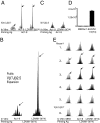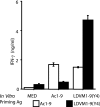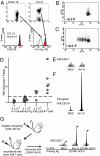Molecular mimics can induce a nonautoaggressive repertoire that preempts induction of autoimmunity
- PMID: 20133742
- PMCID: PMC2823870
- DOI: 10.1073/pnas.0914508107
Molecular mimics can induce a nonautoaggressive repertoire that preempts induction of autoimmunity
Abstract
To determine the role that competition plays in a molecular mimic's capacity to induce autoimmunity, we studied the ability of naïve encephalitogenic T cells to expand in response to agonist altered peptide ligands (APLs), some capable of stimulating both self-directed and exclusively APL-specific T cells. Our results show that although the APLs capable of stimulating exclusively APL-specific T cells are able to expand encephalitogenic T cells in vitro, the encephalitogenic repertoire is effectively outcompeted in vivo when the APL is used as the priming immunogen. Competition as a mechanism was supported by: (i) the demonstration of a population of exclusively APL-specific T cells, (ii) an experiment in which an encephalitogenic T cell population was successfully outcompeted by adoptively transferred naïve T cells, and (iii) demonstrating that the elimination of competing T cells bestowed an APL with the ability to expand naïve encephalitogenic T cells in vivo. In total, these experiments support the existence of a reasonably broad T cell repertoire responsive to a molecular mimic (e.g., a microbial agent), of which the exclusively mimic-specific component tends to focus the immune response on the invading pathogen, whereas the rare cross-reactive, potentially autoreactive T cells are often preempted from becoming involved.
Conflict of interest statement
The authors declare no conflict of interest.
Figures





Similar articles
-
Predicting the effects of potentially therapeutic modified peptides on polyclonal T cell populations in a mouse model of multiple sclerosis.J Neuroimmunol. 2017 Jun 15;307:18-26. doi: 10.1016/j.jneuroim.2017.03.011. Epub 2017 Mar 21. J Neuroimmunol. 2017. PMID: 28495132
-
Fine specificity of the myelin-reactive T cell repertoire: implications for TCR antagonism in autoimmunity.J Immunol. 1998 Oct 1;161(7):3357-64. J Immunol. 1998. PMID: 9759852
-
Altered differentiation, diminished pathogenicity, and regulatory activity of myelin-specific T cells expressing an enhanced affinity TCR.J Immunol. 2011 Dec 1;187(11):5521-31. doi: 10.4049/jimmunol.1102202. Epub 2011 Oct 24. J Immunol. 2011. PMID: 22025553 Free PMC article.
-
T cell response in experimental autoimmune encephalomyelitis (EAE): role of self and cross-reactive antigens in shaping, tuning, and regulating the autopathogenic T cell repertoire.Annu Rev Immunol. 2002;20:101-23. doi: 10.1146/annurev.immunol.20.081701.141316. Epub 2001 Oct 4. Annu Rev Immunol. 2002. PMID: 11861599 Review.
-
Myelin basic protein, MHC restriction molecules and T cell repertoire.Prog Clin Biol Res. 1990;336:93-108. Prog Clin Biol Res. 1990. PMID: 1691512 Review.
Cited by
-
Jeffamine derivatized TentaGel beads and poly(dimethylsiloxane) microbead cassettes for ultrahigh-throughput in situ releasable solution-phase cell-based screening of one-bead-one-compound combinatorial small molecule libraries.J Comb Chem. 2010 Sep 13;12(5):700-12. doi: 10.1021/cc100083f. J Comb Chem. 2010. PMID: 20593859 Free PMC article.
-
CD4+ virtual memory: Antigen-inexperienced T cells reside in the naïve, regulatory, and memory T cell compartments at similar frequencies, implications for autoimmunity.J Autoimmun. 2017 Feb;77:76-88. doi: 10.1016/j.jaut.2016.11.001. Epub 2016 Nov 25. J Autoimmun. 2017. PMID: 27894837 Free PMC article.
-
Pathophysiology of Autoimmune Bullous Diseases: Nature Versus Nurture.Indian J Dermatol. 2017 May-Jun;62(3):262-267. doi: 10.4103/0019-5154.159620. Indian J Dermatol. 2017. PMID: 28584368 Free PMC article.
-
T cell clonal expansions detected in patients with primary biliary cirrhosis express CX3CR1.J Autoimmun. 2011 Sep;37(2):71-8. doi: 10.1016/j.jaut.2011.05.009. Epub 2011 Jun 1. J Autoimmun. 2011. PMID: 21636249 Free PMC article.
References
-
- Bhardwaj V, Kumar V, Geysen HM, Sercarz EE. Degenerate recognition of a dissimilar antigenic peptide by myelin basic protein-reactive T cells. Implications for thymic education and autoimmunity. J Immunol. 1993;151:5000–5010. - PubMed
-
- Hagerty DT, Allen PM. Intramolecular mimicry. Identification and analysis of two cross-reactive T cell epitopes within a single protein. J Immunol. 1995;155:2993–3001. - PubMed
-
- Loftus C, Huseby E, Gopaul P, Beeson C, Goverman J. Highly cross-reactive T cell responses to myelin basic protein epitopes reveal a nonpredictable form of TCR degeneracy. J Immunol. 1999;162:6451–6457. - PubMed
Publication types
MeSH terms
Substances
Grants and funding
LinkOut - more resources
Full Text Sources

